2. 中国石油大学(北京), 北京 102249;
3. 中国石化胜利油田物探研究院, 山东东营 257022
2. China University of Petroleum, Beijing 102249, China;
3. Shengli Geophysical Research Institute of SINOPEC, Shandong Dongying 257022, China
From geological origins,fracture and fluid are closely related. The situation of fracture development (whether or not) and the fluid properties (water or gas) is similar to the four quadrants in rectangular coordinate system,so both the fracture identification and fluid identification items can be constructed using a rectangular coordinate system. Firstly,the fluid factor of Russell is adjusted to the fluid identification item Fluid:cosθ so that the result of adjusted expression is positive when formation contains gas,or negative when formation contains water. Secondly,considering that fracture is sensitive to the P-wave impedance azimuthal anisotropy,and the value of this item is expected to decrease with increasing fracture density, the maximum and minimum of P-wave impedances are introduced to construct the fracture identification item Fracture:sinθ. Therefore,a same parameter angle θ is combined with the two above-mentioned items, which is the expected anisotropy fluid factor. Now that this factor is determined by both fracture and fluid,it is named Factor of Fluid-filled Fracture,FFF for short. In addition,through numerical calculation with a group of representative lithological parameters based on the highly porous unconsolidated sandstone model proposed by Dvorikin,the validity of the FFF in both fracture prediction and fluid identification is verified.
On the basis of theoretical research,fracture and fluid identification of igneous rock in a certain area of the Songliao basin is taken as an application example. With the process of velocity analysis, pre-stack time migration and pre-stack AVO simultaneous inversion,P-wave impedance and S-wave impedance under isotropic condition, the maximum and minimum of P-wave impedances in different azimuths are obtained. By substituting the data above into the expression of FFF,the FFF volume is determined. Comparing the fracture and fluid information in two wells with the predicted results shows a good consistence. In addition,the predicted result is consistent with the gas saturation curve in a well B. So the effectiveness of the new parameter is proved.
Based on the adjustment to fluid factor Russell and P-wave impedance azimuthal anisotropy, a new parameter named FFF is proposed,and its effectiveness is proved with both numerical calculation and practical application. Its technical advantages are as follows: (1) FFF can describe the distribution of fracture and fluid accurately. (2) For different ranges of FFF,fluid saturation can be characterized so that the favorable target can be identified much more conveniently. (3) The minimum and maximum of FFF respectively represent gas-bearing fracture zones and gas zones without fracture,which is intuitive for researchers to understand the characteristics of fracture and gas-bearing properties with the FFF map.
利用振幅随偏移距的变化(Amplitude Versus with Offset,AVO)来进行流体识别是目前应用较广的流体识别方法.Ostr and er(1984)最早发现含气砂岩中地震波的反射系数会随偏移距增加而增加的特征,为利用AVO进行流体识别奠定了基础.为了更细致地研究地层岩性的AVO特征,学者们分别提出了AVO响应特征的划分方案(Rutherford and Williams,1989;Castagna and Smith,1997;Hilterman,2001),在此期间,国内外学者将叠前反演、多属性交汇分析技术与AVO理论相结合,在多个地区的流体识别研究中获得了成功(Mukerji et al.,1998;Ross,2000;李宏兵等,2004;苑书金等,2005;何诚等,2005;陈建江等,2006;邹文等,2008;李爱山等,2007;管路平,2008;郎晓玲等,2010;何涛等,2011;周水生等,2012;程冰洁等,2012).在这些技术的交叉结合中,直接进行流体性质识别的流体因子(Fluid Factor)的概念被提了出来.由AVO叠前反演的弹性参数构建的流体因子,起初是将拉梅系数和剪切模量结合起来进行流体识别(Goodway et al.,1997),之后,国外学者基于纵横波阻抗和提出了各自的流体因子(Hilterman,2001;Lucia et al.,2003;Russell,2003),国内的科研人员也在前人研究的基础上提出了灵敏度更高的流体因子(宁忠华,2006;王栋等,2008,2009).
但是,以上的各种流体因子均是在地下介质为各向同性的前提下提出的.近年来,伴随着各向异性理论的发展,学者们也开始将目光投向与各向异性介质、尤其是裂缝相关的流体预测中,进行了与裂缝相关的流体识别研究(Sayers,1990;Tod and Liu,2002;Shaw and Sen,2006).但是,直接进行裂缝流体识别的裂缝流体识别因子仍然较少(Liu et al.,2008;Cui,2010).
纵观流体识别这几十年的研究内容,由各向同性AVO反演的弹性参数组合到近年来的各向异性流体预测,学者们通过理论研究及应用实践将所研究的地质模型一步步逼近真实的地下岩层.从这个大趋势来看,与各向异性介质有关的流体预测或裂缝流体识别将是流体预测研究的发展方向.但是,目前国内外关于裂缝流体识别的理论研究及实际应用仍然较少,本文研究的目的正是为了丰富这一相对空白的研究领域.研究中通过对裂缝流体因子的构建、岩石参数检验及实际数据应用,提出一种能够同时预测裂缝、流体发育情况,且能够表征含气饱和度的裂缝流体因子,并在实际应用中讨论其有效性和局限性.
2 原理及思路 2.1 裂缝流体因子构建从地质成因来看,裂缝与流体是密切相关的.构建裂缝流体因子的最终目的,就是希望找出一个物理量,使它既能够表征地下岩层裂缝的发育情况,又能进行地层的流体识别.也就是说,该物理量应该能够表征地层如下四种情况的差异:地层含水、裂缝不发育,地层含气、裂缝不发育,地层含水、裂缝发育,地层含气且裂缝发育.地层裂缝是否发育以及地层所含流体性质对应的四种不同地层情况,与直角坐标系中由x,y取值不同来确定坐标点在四个象限中的位置具有相似性.那么,可以将两者相结合,用直角坐标系内某一点的四种正负值情况来对应由裂缝、流体确定的四种不同地层情况,如图 1.
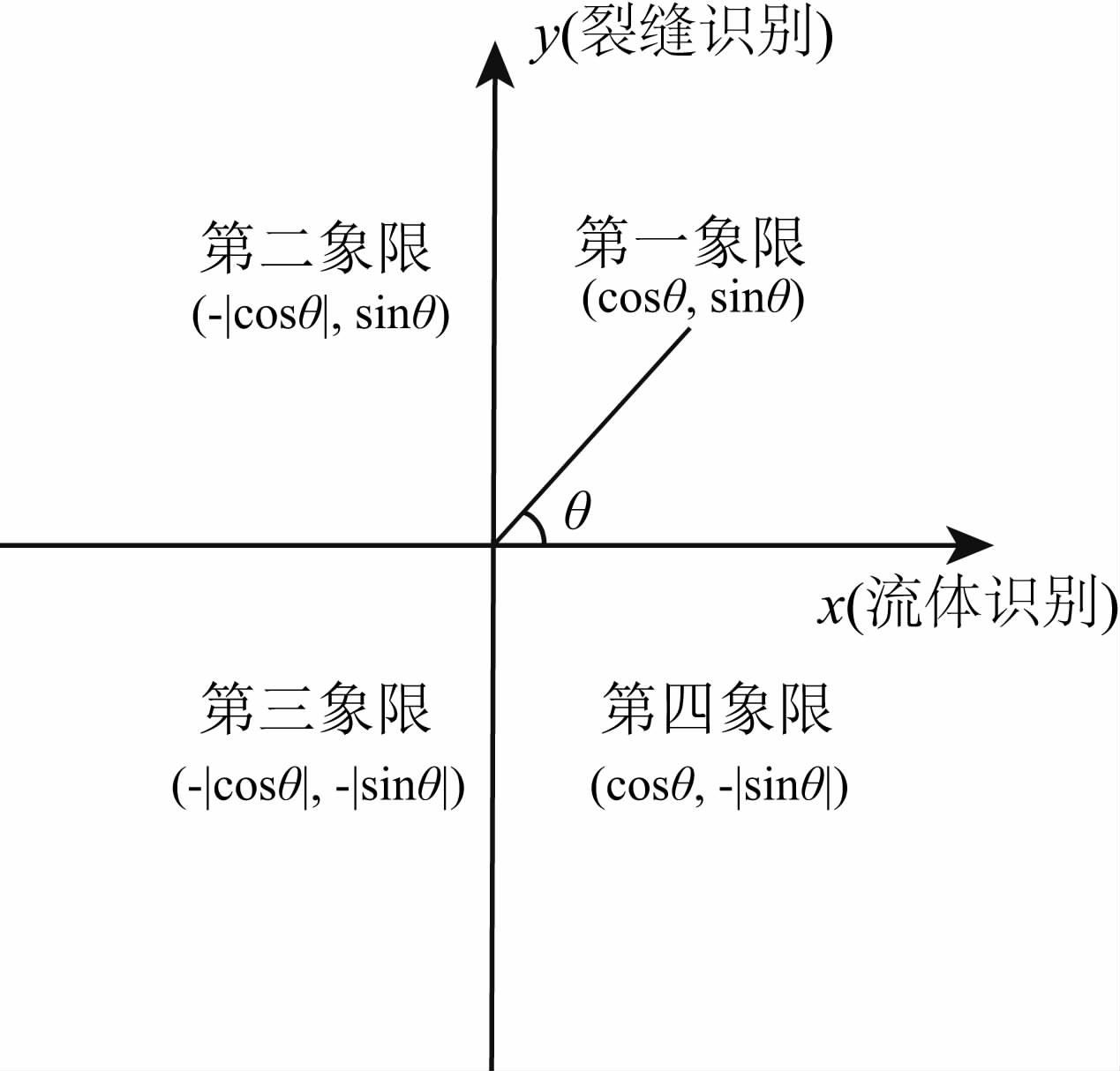 |
图 1 裂缝流体因子构建 Fig. 1 Construction of the factor of fluid-filled fracture |
根据这种思路,结合直角坐标系来分别构建裂缝识别项和流体识别项.在进行流体识别时,引入 Russell等(2003)定义的流体因子公式,如式(1),式中ρf为流体因子,c为调节参数,在地层含水时,ρf为明显正高值,在地层含气时,ρf为明显正低值.

考虑到岩石含气时纵波速度比含水时纵波速度小,对Russell的流体因子进行调整,使调整后的表达式在含气时值为正,含水时值为负,得到流体识别项,如式(2)

在进行裂缝识别时,考虑到裂缝对纵波阻抗方位各向异性的影响较为明显(贺振华等,2007),并希望裂缝识别项的取值随裂缝强度的增加而减小,因此,对裂缝项进行如下定义:


当地层各向异性强度较大,裂缝为可识别时,Fracture:sinθ为正值,且裂缝越发育,Fracture:sinθ的值越小;当地层各向异性强度较小,裂缝为不可识别时,Fracture:sinθ为负值;特殊地,当IPmax=AIPmin时,认为该情况下地层裂缝不可识别,令Fracture:sinθ的值为1,对应θ为90°.
将上述关于裂缝识别、流体识别的讨论通过同一角度θ综合起来,得到:

裂缝流体因子FFF的取值范围为0~360,结合正弦函数和余弦函数在0°~360°范围内的单调性,裂流因子的物理意义及其与流体饱和度的关系如表 1及图 2:①当值为0~90时,地层含气,且裂缝为可识别,FFF值越小,地层含气饱和度越高;②当值为90~180时,地层含水,且裂缝为可识别,FFF值越大,地层含水饱和度越高;③当值为180~270时,地层含水,但无裂缝或裂缝不可识别,FFF值越小,地层含水饱和度越高;④当值为270~360时,地层含气,但无裂缝或裂缝不可识别,FFF值越大,地层含气饱和度越大.此外,在坐标轴附近裂流因子的物理意义较为特殊,x轴附近(FFF值为近0或180时)代表裂缝、流体发育区,y轴附近(FFF值为近90或 270时)代表裂缝发育情况不同的干层,且FFF值为90时,对应无裂缝干层.
| 表 1 裂流因子FFF物理意义 Table 1 Physical meaning of FFF |
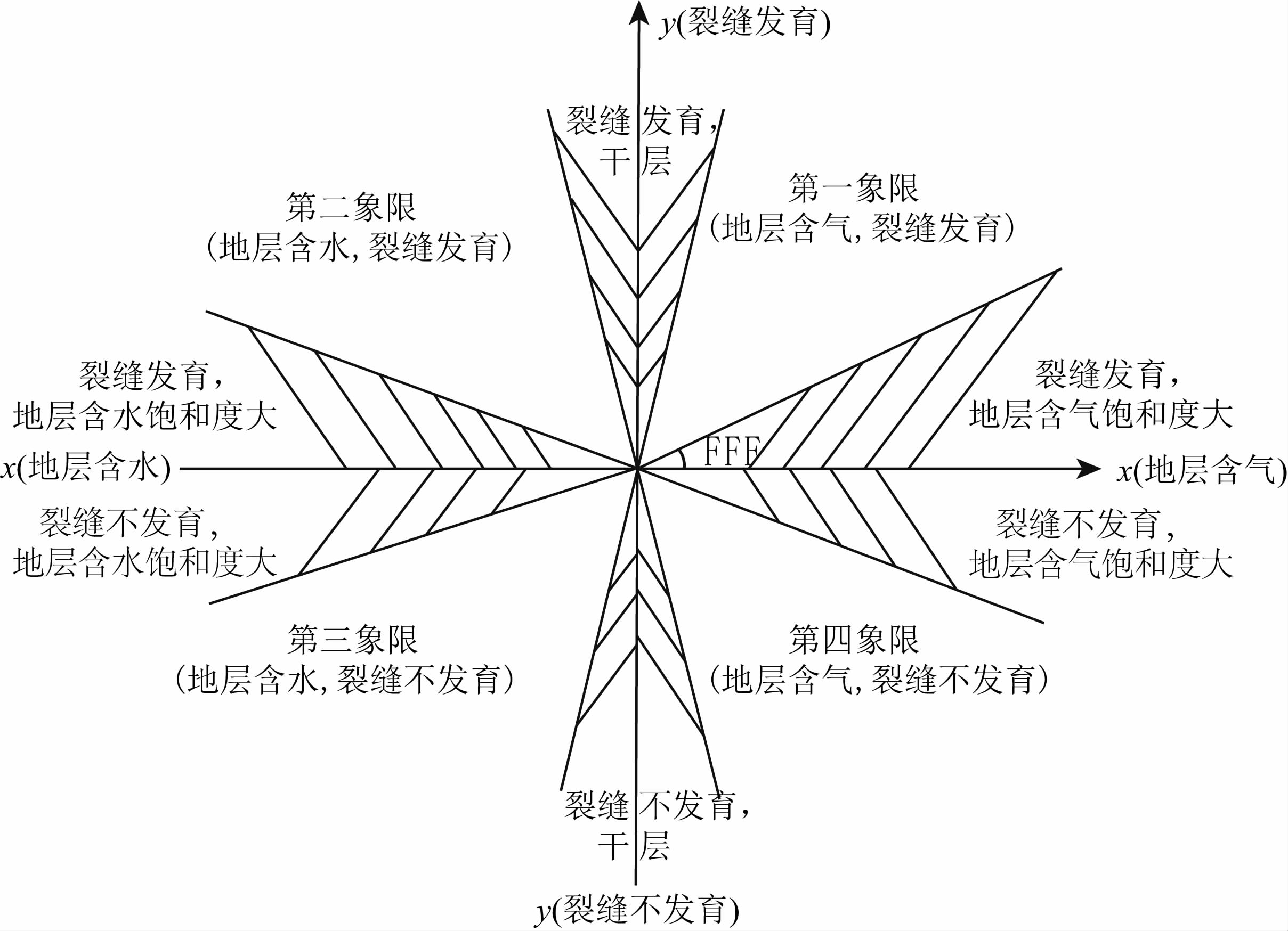 |
图 2 裂缝流体因子物理意义示意图 Fig. 2 Physical meaning of the factor of fluid-filled fracture |
在完成裂缝流体因子构建后,接下来要做的就是通过岩性参数来检验其准确性.当基质砂岩围体的纵波、横波速度及密度分别为6040、4070 m·s-1和2.65 g·cm-3时,根据Dvorikin和Nur(1996)提出的高孔隙疏松砂岩模型计算出孔隙度为15%时饱含气砂岩、饱含水砂岩围体的岩性参数表,同时给出地层为各向同性、裂缝为不可识别以及裂缝为可 识别时的岩性参数,如表 2.取裂流因子中裂缝项系数A为1.05(认为裂缝造成纵波各向异性强度大于1.05时,为可识别裂缝),流体项系数B取砂岩纵横波速度比的平方2.9,裂缝项调节参数C取10,根据式(5)分别计算不同地层岩性参数下裂流因子FFF的值,如表 2.从表中最后两列的运算结果可以看出,裂流因子FFF能够准确定位到表征不同裂缝、流体性质的象限中,检验效果较好.
| 表 2 裂缝流体因子的岩性参数检验 Table 2 Verification of FFF with a group of lithology parameters |
研究区位于松辽盆地南部北端某地区,目的层为白垩系营城组火山岩,如图 3,地层厚度变化较大(350~900 m),如图 4.2007年在火山岩的有利相 带部署一口探井A井,在营城组使用50.8 mm油嘴获日产天然气592 m3,水62 m3,在A井的基础上,2008年9月22日部署了另外一口探井B,在营城组使用12 mm油嘴获天然气日产量20.2464×104m3,揭示了该地区火成岩的勘探潜力.
A井和B井的钻探成功,打开了松辽盆地南部研究区深层天然气勘探局面.根据钻井资料分析,该地区火山岩储层由孔、洞、缝组成.其中原生和次生孔隙是主要储集空间,裂缝是仅次于孔隙的储集空间.对储层连通性和流体运移而言,裂缝是最主要的通道,利用现有技术手段开展研究区火山岩储层裂缝及流体分布特征的研究工作意义重大.
 |
图 3 研究区营城组顶面构造图 Fig. 3 Structural map of Yingcheng formation in study area |
 |
图 4 目的层地震剖面 Fig. 4 Seismic section of target layer |
在经过正常时差校正(Normal Moveout,NMO)的叠前地震道集基础上,利用叠前AVO同步反演计算出各向同性下的纵横波速度、密度数据体,再分别计算出对应的纵横波阻抗;对NMO道集进行方位角道集抽取,并分别进行速度分析及叠前时间偏移,以得到的各分方位角共反射点(Common Reflection Point,CRP)道集为基础,分别进行叠前AVO同步反演,得到各方位角的纵波阻抗,通过对比每个采样点不同方位角纵波阻抗的值,可以计算 出方位角纵波阻抗的最大值和最小值.将以上参数代入式(5),并取裂缝项系数A为1.05,流体项 系数B为3,裂缝项调节参数C为9,以营城组顶 底层位为时窗约束,即可得到研究区裂缝流体因子数据体.
对裂缝流体因子的剖面图进行分析,将裂流因子低值调整为红色,高值为蓝色,如图 5.单从裂缝 预测情况来看,A井和B井在成像测井上的裂缝发育段均对应裂流因子的低值区;从裂缝和流体识别的综合情况来看,B井营城组顶部裂缝含气井段及下部的含水井段分别对应裂缝流体因子的低值和中低值,吻合情况较好,A井在含气裂缝发育位置也表现出明显的低值,但气层下面的干层井段与预测结果略有差异.通过与井上裂缝、含气情况的对比来 看,整体吻合程度较好,局部预测精度还有提升的空间.
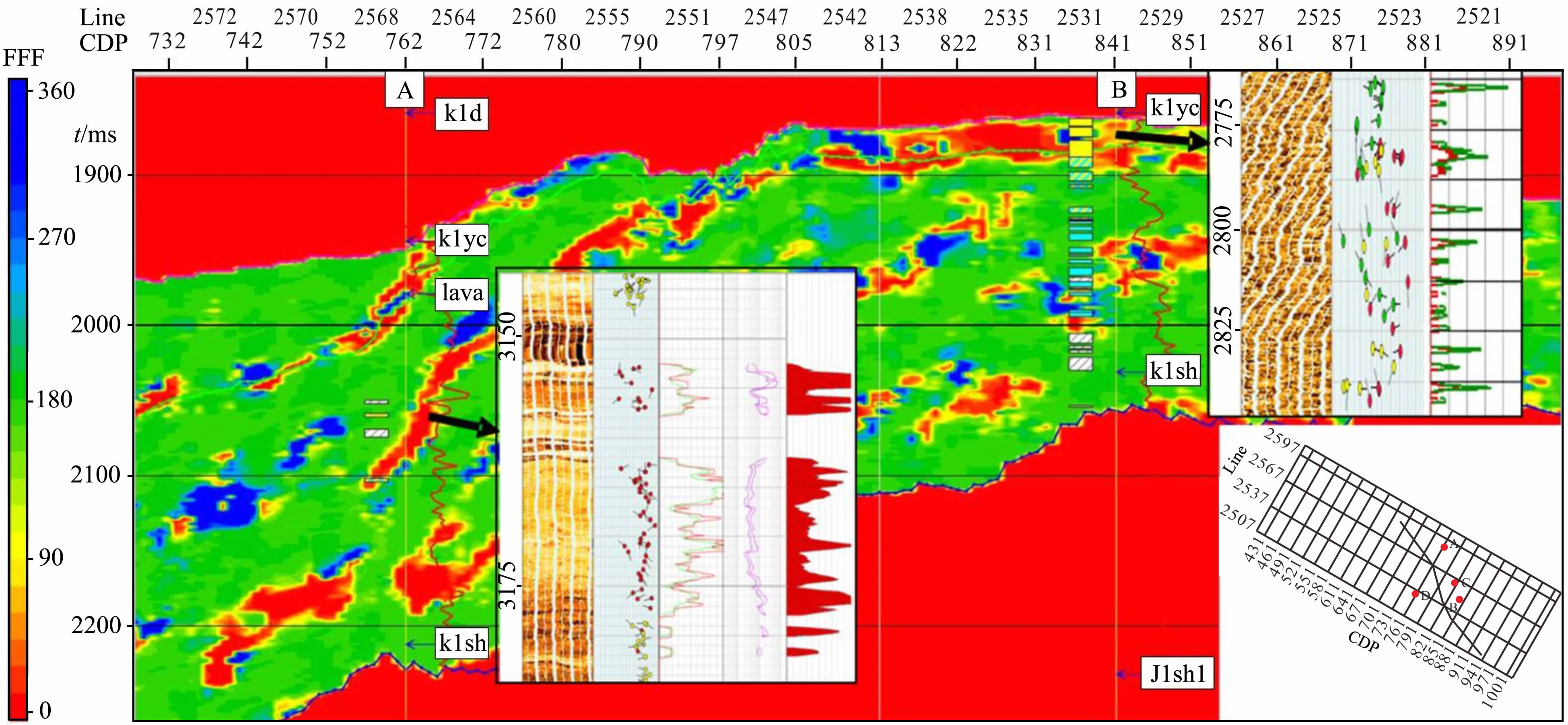 |
图 5 营城组裂流因子连井剖面 Fig. 5 Section of the FFF for Yingcheng formation |
裂缝流体因子的一个很大的优势是能够对含气饱和度进行定性的判断.测井资料中,B井有含气饱和度曲线,为了考察裂流因子对含气饱和度的识别效果,由裂流因子数据体提取B井位置的曲线值,与B井的含气饱和度曲线进行对比,如图 6和7.在 B井2747~2800 m井段附近,含气饱和度为高值,对应的裂流因子FFF取值均在0~90之间,在2782 m附近为含气饱和度峰值,对应的裂流因子也趋向于 0;在2800~2900 m,含气饱和度逐渐下降,裂流因子FFF取值在180附近,表现为低含气饱和度,高含水饱和度.从对比情况来看,B井含气饱和度与裂流因子FFF的整体趋势一致,证明了裂缝流体因子在含气饱和度判别上的有效性.
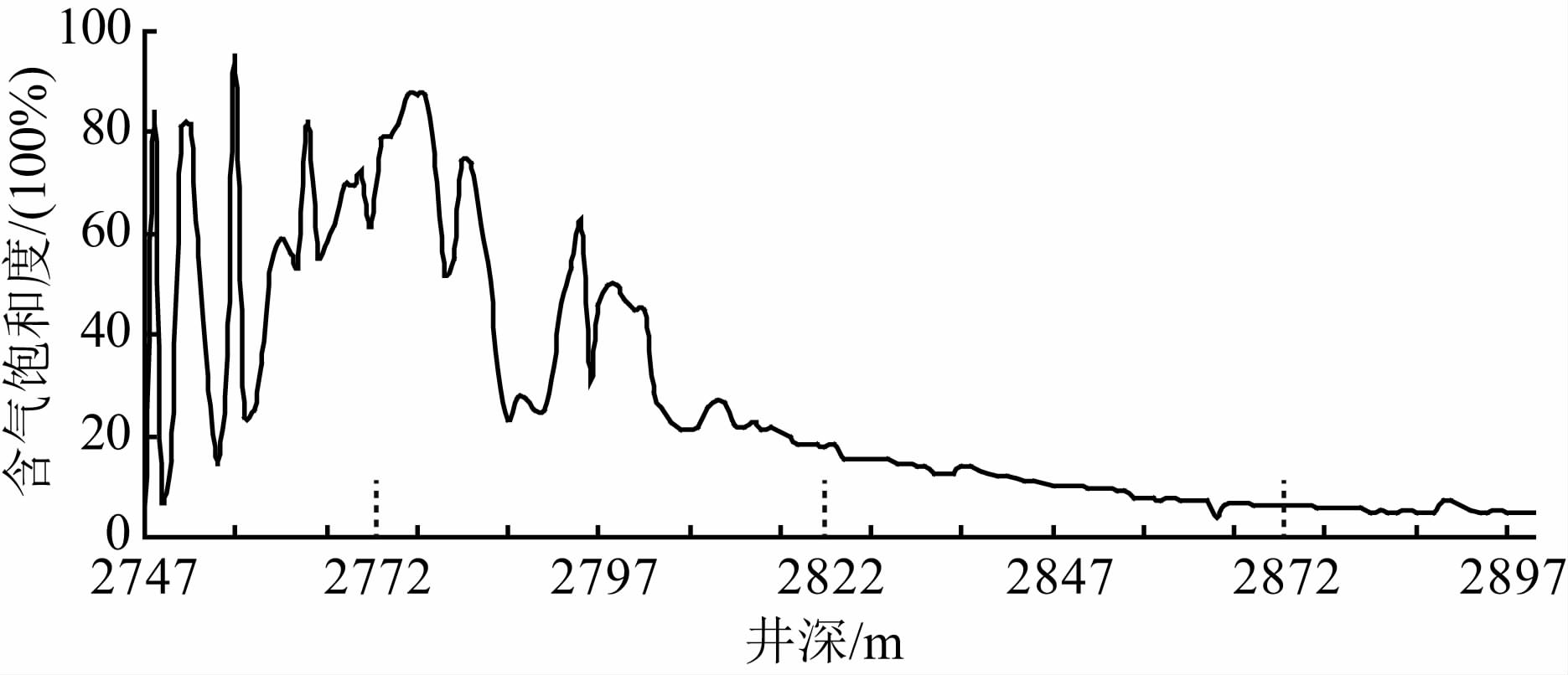 |
图 6 B井含气饱和度 Fig. 6 Gas saturation curve of well B |
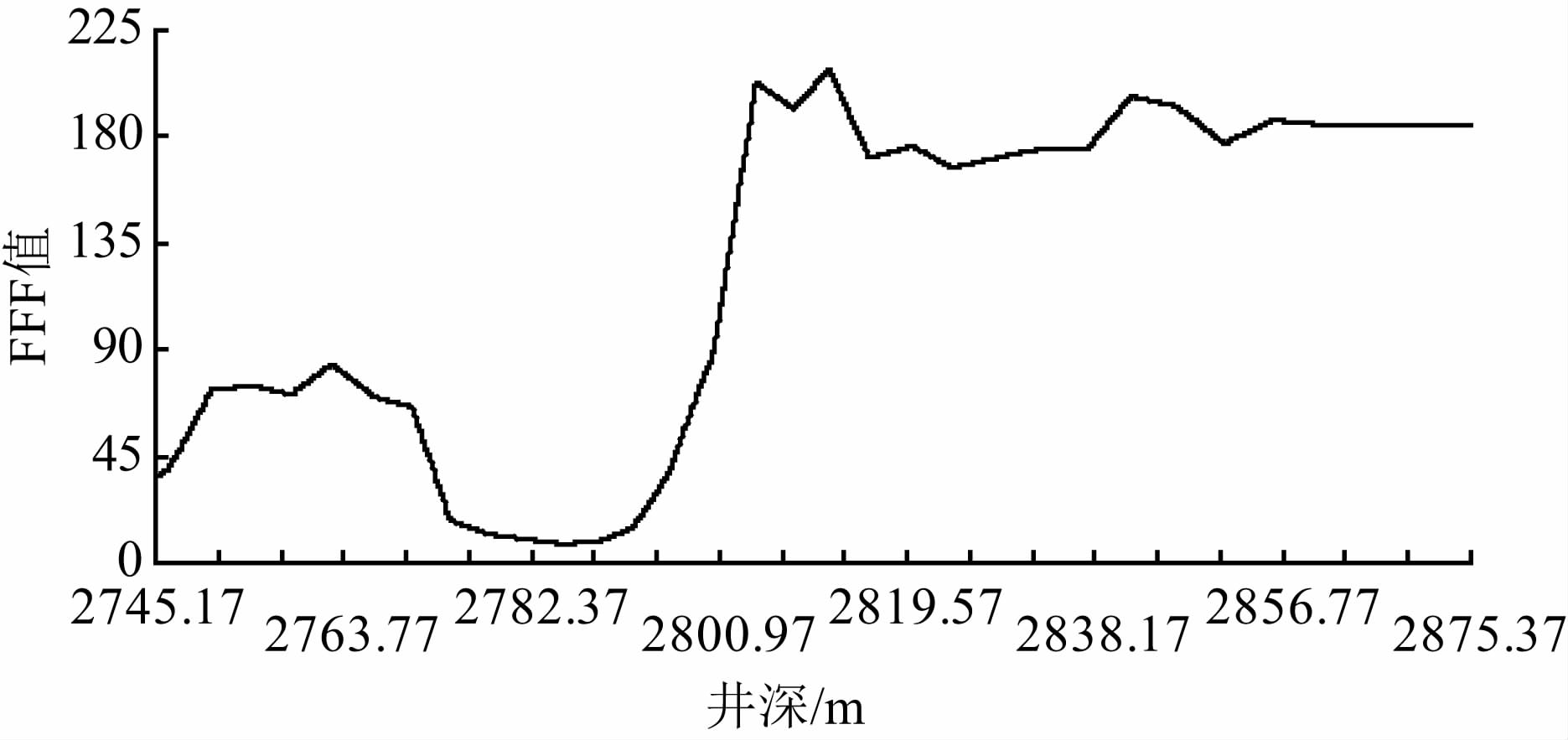 |
图 7 B井FFF值 Fig. 7 Gas saturation curve of well B |
对裂流因子数据体进行平面成图,如图 8,9.在营城组上部(营二三四段)地层的有利裂缝含气带为B井区附近的小片区域(图中黑色虚线范围内),在 营城组下部(营一段)的分布范围则较广,根据井上的地质认识,裂流因子在营城组上部地层的预测结果与井上的差异不大,但是,在营城组下部的预测结果与井上差异很大.经过分析发现裂缝流体因子在进行平面成图时,存在明显的局限性.
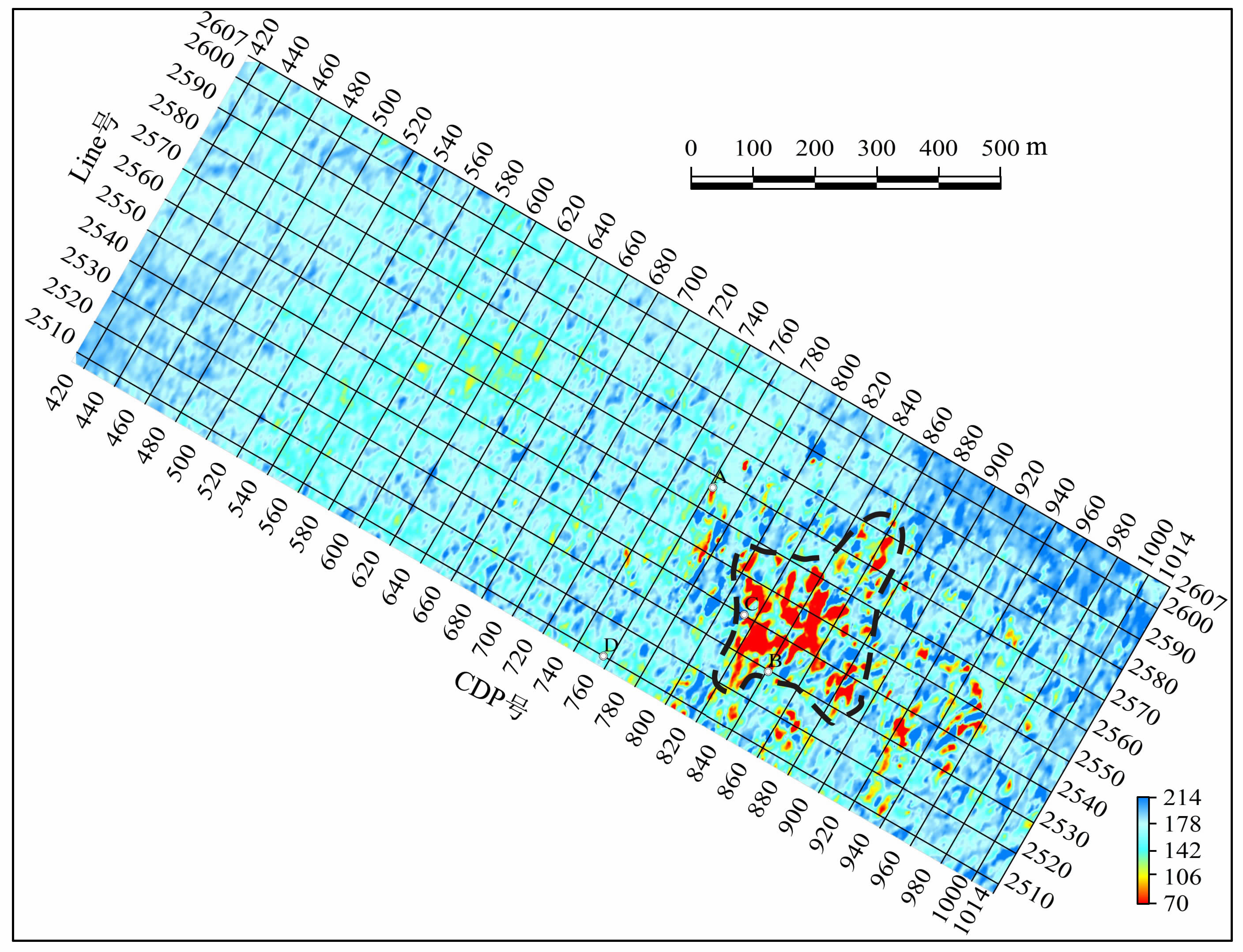 |
图 8 营城组上部裂流因子平面图 Fig. 8 Plane view of FFF for top of Yingcheng formation |
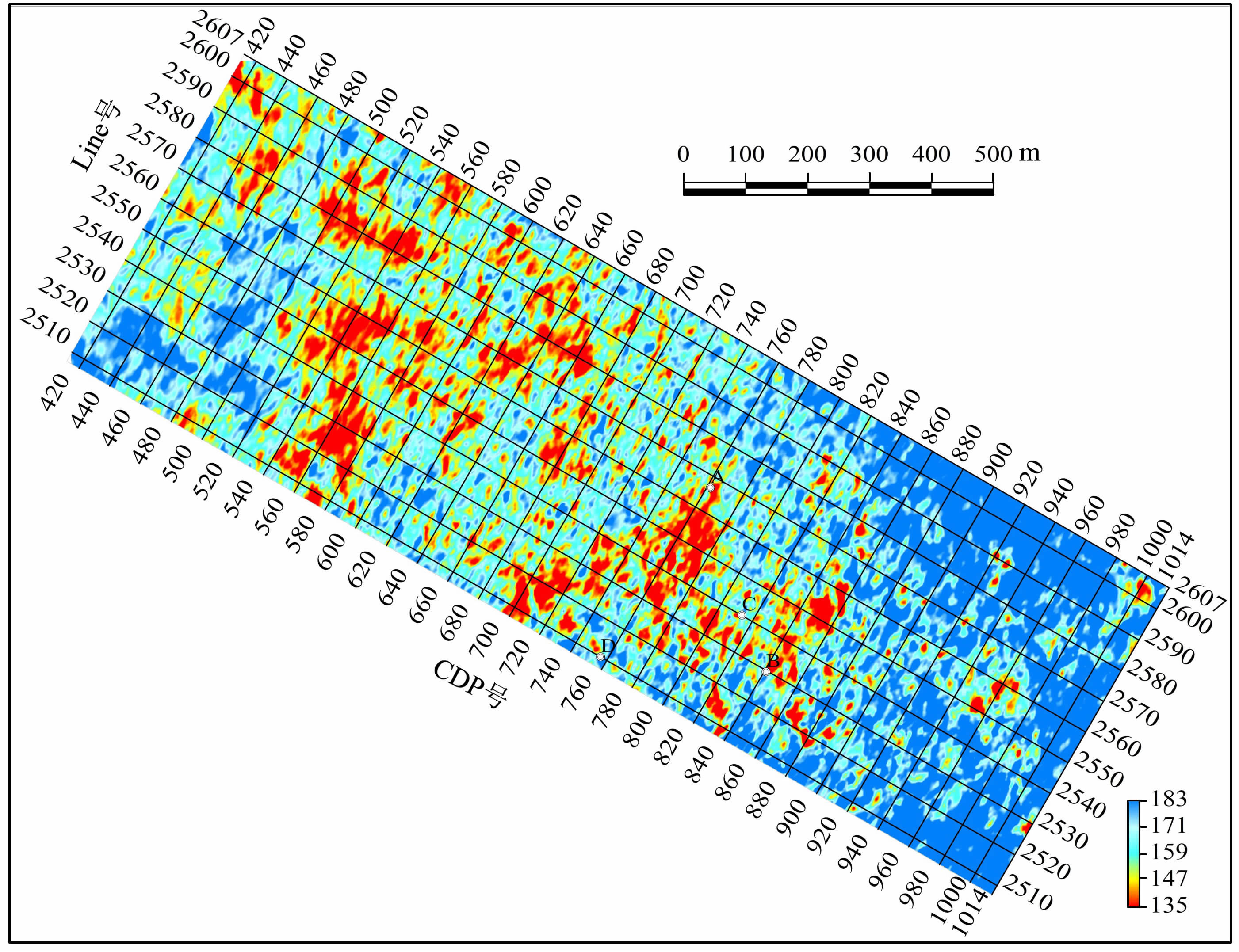 |
图 9 营城组下部裂流因子平面图 Fig. 9 Plane view of FFF for bottom of Yingcheng formation |
对于波阻抗等属性,研究人员关心的是有利储层对应的波阻抗是高值还是低值,在平面成图时,沿地震层位或某一时窗取平均或均方根,能够大致表现出有利储层的平面分布特征.但是,裂流因子在平面成图时,其物理意义会发生变化,对于2 ms采样的地震数据,若计算出的裂流因子在2010 ms时值为35(裂缝含气地层)、2012 ms时值为350(无裂缝含气地层),2014 ms时值为40(裂缝含气地层),这时,为了观察平面特征,对时窗2010~2014 ms内的4 ms数据取平均,得到平均值为106(裂缝含水地层);类似的,对时窗2010~2014 ms内的4 ms数据取均方根,得到均方根值为204(无裂缝含水地层).无论是取平均还是取均方根,得到的平面属性均已不代表裂流因子实际的物理意义,也就是说裂流因子受地层厚度影响非常大(如研究中,营一段地层厚度变化极为剧烈,对平面分布特征影响严重,得到的裂缝流体分布特征与井上的差异较大),这一问题的主要原因是裂流因子的数值在不同值域范围内表征了裂缝、流体各异的四种地层性质.因此,在裂流因子平面成图时,一定要根据实际地层情况,谨慎选取 时窗.此外,裂流因子无法直观地描述出裂缝的走向.
4 结论和讨论本文基于对Russell流体因子的简单变换及波阻抗方位各向异性,构建了裂缝流体因子FFF,并通过一组岩性参数和实际工区的应用检验了裂流因子的有效性,其技术优势如下:①FFF能够准确地 表征地层的裂缝发育情况及流体性质,通过对FFF 的分析,能够清晰地描述地下岩层裂缝和流体的空间分布特征;②在不同值域范围内,FFF与流体饱和度均有对应关系,更易于寻找最有利的勘探目标区;③勘探人员最为关注的含气裂缝发育带对应的FFF为低值,研究人员进行最终的地质成果绘图时,将FFF最低值标示为暖色调(如红色),FFF最高值(含气无裂缝)标示为冷色调(如蓝色),即可直观地把握研究区的裂缝及含气性特征.
裂流因子在剖面上的预测准确率较高,且与单井含气饱和度的吻合度非常好,证实了该因子的有效性.但是,由于裂流因子的数值在不同值域范围内表征了裂缝、流体各异的四种地层性质,在对裂流因子数据体进行平面成图时,其数值受地层厚度影响非常明显,因此,在利用裂流因子进行裂缝、流体平面分布特征预测时,时窗的控制一定要十分谨慎.此外,裂流因子无法直观地描述出裂缝的走向.
致谢 作者衷心感谢中国地质大学(北京)王彦春教授、刘学清博士、方圆博士,中国地质科学院刘志伟 博士以及二位匿名审稿专家对本文提出的宝贵建议!
| [1] | Castagna J P, Smith S W. 1997. Principles of AVO cross-plotting. The Leading Edge, 16(4): 337-341. |
| [2] | Chen J J, Yin X Y, Zhang G Z. 2006. Prestack AVO inversion of layered medium. Oil Geophysical Prospecting (in Chinese), 41(6): 656-662. |
| [3] | Cheng B J, Xu T J, Li S G. 2012. Research and application of frequency dependent AVO analysis for gas recognition. Chinese Journal of Geophysics (in Chinese), 55(2): 608-613, doi: 10.6038/j.issn.0001-5733.2012.02.023. |
| [4] | Cui J, Han L G, Liu Q K, et al. 2010. P-SV wave elastic impedance and fluid identification factor in weakly anisotropic media. Applied Geophysics, 7(2): 135-142. |
| [5] | Dvorikin J, Nur A. 1996. Elasticity of high-porosity sandstones: theory for two North Sea data sets. Geophysics, 61(5): 1363-1370. |
| [6] | Goodway B, Chen T, Downton J. 1997. Improved AVO fluid detection and lithology discrimination using Lame petrophysical parameters: "Lamda-Rho", "Mu-Rho", &"Lamda/Mu fluid stack", from P and S inversions. // 67th Annual International Meeting, SEG. Expanded Abstract, 183-186. |
| [7] | Guan L P. 2008. Pre-stack inversion and direct hydrocarbon indicator. Geophysical Prospecting for Petroleum (in Chinese), 47(3): 228-234. |
| [8] | He C, Cai Y H, Li H, et al. 2005. Application of AVO attributes crossplot interpretation technique to predict carbonate reservoir. Oil Geophysical Prospecting (in Chinese), 40(6): 711-715. |
| [9] | He T, Shi G, Zou C C, et al. 2011. The uncertainty analysis of the key factors that affect the AVO attributes in sandstone reservoir. Chinese Journal of Geophysics (in Chinese), 54(6): 1584-1591, doi: 10.3969/j.issn.0001-5733.2011.06.018. |
| [10] | He Z H, Huang D J, Wen X T. 2007. Geophysical Predictive Theory and Technique on Fractured Reservoir (in Chinese). Chengdu: Sichuan Publishing House of Science and Technology. |
| [11] | Hilterman F J. 2001. Seismic Amplitude Interpretation, Distinguished Instructor Short Course. Society of Exploration Geophysicists. |
| [12] | Lang X L, Peng S M, Kang H Q, et al. 2010. Application of prestack simultaneous inversion in fluid identification. Geophysical Prospecting for Petroleum (in Chinese), 49(2): 164-169. |
| [13] | Li A S, Yin X Y, Zhang F C, et al. 2007. Application of prestack simultaneous AVA multi-parameter inversion in gas-bearing reservoir prediction. Geophysical Prospecting for Petroleum (in Chinese), 46(1): 64-68. |
| [14] | Li H B, Zhao W Z, Cao H, et al. 2004. Characteristics of seismic attenuation of gas reservoirs in wavelet domain. Chinese Journal of Geophysics (in Chinese), 47(5): 892-898, doi: 10.3321/j.issn:0001-5733.2004.05.022. |
| [15] | Liu Q K, Han L G, Wang E L, et al. 2008. Reflection coefficients of P-SV waves in weak anisotropic media. Applied Geophysics, 5(1): 18-23. |
| [16] | Lucia F J, Kerans C, Jenningd J W Jr. 2003. Carbonate reservoir characterization. Journal of Petroleum Technology, 55(6): 70-72. |
| [17] | Mukerji T, Jrstad A, Mavko G, et al. 1998. Near and far offset impedances: Seismic attributes for identifying lithofacies and pore fluids. Geophysical Research Letters, 25(24): 4557-4560. |
| [18] | Ning Z H, He Z H, Huang D J. 2006. High sensitive fluid identification based on seismic data. Geophysical Prospecting for Petroleum (in Chinese), 45(3): 239-241. |
| [19] | Ostrander W J. 1984. Plane-wave reflection coefficients for gas sands at nonnormal angles of incidence. Geophysics, 49(10): 1637-1648. |
| [20] | Ross C P. 2000. Effective AVO crossplot modeling: A tutorial. Geophysics, 65(3): 700-711. |
| [21] | Russell B H, Hedlin K, Hilterman F J, et al. 2003. Fluid-property discrimination with AVO: A Biot-Gassmann perspective. Geophysics, 68(1): 29-39. |
| [22] | Rutherford S R, Williams R H. 1989. Amplitude-versus-offset variations in gas sands. Geophysics, 54(6): 680-688. |
| [23] | Sayers C M. 1990. Stress-induced fluid flow anisotropy in fractured rock. Transport in Porous Media, 5(3): 287-297. |
| [24] | Shaw R K, Sen M K. 2006. Use of AVOA data to estimate fluid indicator in a vertically fractured medium. Geophysics, 71(3): C15-C24. |
| [25] | Tod S R, Liu E R. 2002. Frequency-dependent anisotropy due to fluid flow in bed limited cracks. Geophysical Research Letters, 29(15): 39-1-39-4. |
| [26] | Wang D, He Z H, Huang D J. 2009. Construction of a new fluid identification factor and analysis on its application. Geophysical Prospecting for Petroleum (in Chinese), 48(2): 141-145. |
| [27] | Wang D, He Z H, Huang D J. 2008. Research of high sensitive fluid identifying factor in water containing sandstone. Journal of Yangtze University (Nat. Sci. Edit.) (in Chinese), 5(3): 45-47. |
| [28] | Yuan S J, Dong N, Yu C Q. 2005. Study of prestack joint inversion of P-wave impedance and S-wave impedance and its application. Oil Geophysical Prospecting (in Chinese), 40(3): 339-342. |
| [29] | Zhou S S, Yi W, Hao Z B, et al. 2012. Experiment research and application of fluid sensitive attributes based on the pre-stack inversion. Chinese Journal of Geophysics (in Chinese), 55(6): 1985-1992, doi: 10.6038/j.issn.0001-5733.2012.06.020. |
| [30] | Zou W, He Z H, Chen A P, et al. 2008. Application of quantitative crossplot technique in fluid identification. Geophysical Prospecting for Petroleum (in Chinese), 47(1): 45-48. |
| [1] | 陈建江, 印兴耀, 张广智. 2006. 层状介质AVO叠前反演. 石油地球物理勘探, 41(6): 656\662. |
| [2] | 程冰洁, 徐天吉, 李曙光. 2012. 频变AVO含气性识别技术研究与应用. 地球物理学报, 55(2): 608\613, doi: 10.6038/j.issn.0001\5733.2012.02..023 |
| [3] | 管路平. 2008. 地震叠前反演与直接烃类指示的探讨. 石油物探, 47(3): 228\234. |
| [4] | 何涛, 史謌, 邹长春等. 2011. 砂岩储层AVO特征影响因素的不确定性研究. 地球物理学报, 54(6): 1584\1591, doi: 10.3969/j.issn.0001\5733.2011.06..018 |
| [5] | 何诚, 蔡友洪, 李邗等. 2005. AVO属性交会图解释技术在碳酸盐岩储层预测中的应用. 石油地球物理勘探, 40(6): 711\715. |
| [6] | 贺振华, 黄德济, 文晓涛. 2007. 裂缝油气藏地球物理预测. 成都: 四川科学技术出版社. |
| [7] | 郎晓玲, 彭仕宓, 康洪全等. 2010. 叠前同时反演方法在流体识别中的应用. 石油物探, 49(2): 164\169. |
| [8] | 李爱山, 印兴耀, 张繁昌等. 2007. 叠前AVA多参数同步反演技术在含气储层预测中的应用. 石油物探, 46(1): 64\68. |
| [9] | 李宏兵, 赵文智, 曹宏等. 2004. 小波尺度域含气储层地震波衰减特征. 地球物理学报, 47(5): 892\898, 022doi: 10.3321/j.issn:0001\5733.2004.05.. |
| [10] | 宁忠华, 贺振华, 黄德济. 2006. 基于地震资料的高灵敏度流体识别因子. 石油物探, 45(3): 239\241. |
| [11] | 王栋, 贺振华, 黄德济. 2009. 新流体识别因子的构建与应用分析. 石油物探, 48(2): 141\145. |
| [12] | 王栋, 贺振华, 黄德济. 2008. 含气含水砂岩的高灵敏度流体识别因子的研究. 长江大学学报(自然科学版), 5(3): 45\47. |
| [13] | 苑书金, 董宁, 于常青. 2005. 叠前联合反演P波阻抗和S波阻抗的研究及应用. 石油地球物理勘探, 40(3): 339\342. |
| [14] | 周水生, 宜伟, 郝召兵等. 2012. 基于叠前反演的流体敏感属性实验研究及应用. 地球物理学报, 55(6): 1985\1992, 020doi: 10.6038/j.issn.0001\5733.2012.06.. |
| [15] | 邹文, 贺振华, 陈爱萍等. 2008. 定量交会图技术及其在流体识别中的应用. 石油物探, 47(1): 45\48. |
 2015, Vol. 58
2015, Vol. 58

